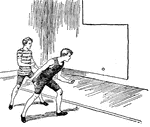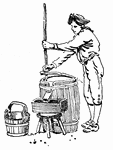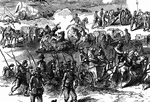
Battle of White Oak Swamp Bridge
"Battle of White Oak Swamp Bridge, Monday June 30th, 1862- Ayres's, Mott's and Randall's batteries checking…

Jamestown Island
"Distant view of Jamestown Island. This view is from the north side of what was once a marsh, but now…
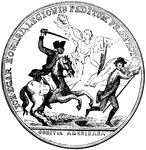
Howard Medal Front
"Silver medal awarded to Colonel Howard. The following are the device and inscriptions upon the front:…

Washington Medal Front
"Silver medal awarded to Washington. The following are the device and inscriptions on the front: An…

Blackspotted Pliers Support Beetle
"The Leptura Mordax, or Rhagium Mordax of Europe, three-fourths of an inch long,…

Aquarius
"A zodiacal constellation, supposed to represnt a man standing with his left hand extended upward, and…
!["Like that animal [the mole] it is constantly engaged in burrowing in the earth; and to enable it to do this with facility iits anterior limbs are converted into a pair of flat, fossorial organs, which are turned outward in exactly the same manner as the hand of the mole. In its pasage through the earth it does great injury to the roots of plants, but it said to live quite as much upon animal as vegetable food." — Goodrich, 1859](https://etc.usf.edu/clipart/14900/14935/molecricket_14935_mth.gif)
Mole Cricket
"Like that animal [the mole] it is constantly engaged in burrowing in the earth; and to enable it to…
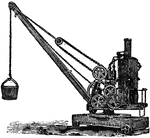
Steam Crane
"A Crane is a machine for lifting weights, worked either by hand or by steam, or by hydraulic power.…

17th Century French Fan
"A Fan is an instrument used by ladies to agitate the air, and cool the face, in warm weather; hence,…

18th Century Spanish Shell Fan
"A Fan is an instrument used by ladies to agitate the air, and cool the face, in warm weather; hence,…

Steam Fire Engine
"A Fire Engine is a machine employed for throwing a jet of water for the purpose of extinguishing fires.…
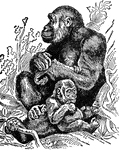
Female Gorilla
"The Gorilla is a celebrated anthropoid ape, generally belived to come nearer than any known one to…

Transverse section of the small intestine
"In the figure on the left are seen the artery and vein of a villus. In the right figure are represented…

Outer skin
"A Layer of the Outer Skin from the Palm of the Hand. Detached by maceration." — Blaisedell, 1904
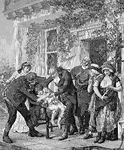
The First Vaccination
"This picture is based upon a photograph of a painting exhibited many years ago in the Paris Salon.…

Surface of the palm
"Surface of Palm of the Hand, showing Openings of Sweat Glands and Grooves between Papillae of the Skin.…

Superficial Nerves of the Forearm and Hand
"Superficial, or Cutaneous, Nerves on the Back of the Left Forearm and Hand." — Blaisedell, 1904

Hand seat
"Improvised Hand Seats: the Three-Handed Seat. THe usefull three-handed seat is made by one bearer grasping…

Hand seat
"Showing how the Improvised Three-Handed Seat may be used to carry an Injured Person. The picture also…

Palmistry
"Palmistry, or Chiromancy, is the art which professes to discover the temperament and character of anyone,…
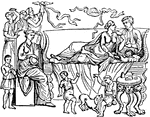
Accubatio
"The act of reclining at meals. The Greeks and Romans were accustomed, in later times, to recline at…
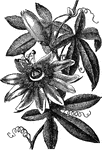
Passion Flower
"Pasiflora is the passion-flower. Generally climbing herbs or shrubs. Fruit succulent, seeds many. Found…

Ancile
"Ancilia carried by Salii. The sacred shield carried by the Salii, and made of bronze. The original…

Antyx
"The rim or border of anything, especially of a shield or chariot. The trim of the large round shield…

Ascia
"An adze. Muratori has published numerous representations of the adze, as it is exhibited on ancient…

Cantharus
"A king of drinking cup, furnished with handles. It was the cup scred to Bacchus, who is frequently…

Chirodota
"A tunic with sleeves. The tunic of the Egyptians, Greeks and Romans was originally without sleeves,…
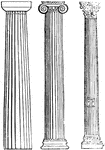
Columna
"A pillar or column. The use of the trunks of trees placed upright for supporting buildings, unquestionably…

Crotalum
"A kind of cymbal. It appears to have been a split reed or cane, which clattered when shaken with the…
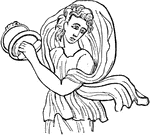
Cymbalum
"A musical instrument, in the shape of two half globes, which were held one in each hand of the performer,…
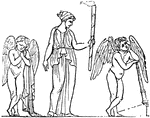
Fax
"A torch. In the annexed woodcut, the female figure is copied from a fictile vase. The winged figure…
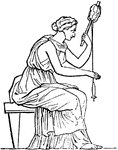
Fusus
"The spindle, was always, when in use, accompanied by the distaff, as an indispensable part of the same…

Ring the Bull
"This amusing game requires more care and delicacy of touch than at first seems to be the case. The…
Whizzer
"Get a circular piece of tin, three inches or more in diameter, and cut it round the edges in the form…

Cudgel Game
"Here is a new game, which is causing a great deal of amusement at social gatherings in Europe. Two…

Jackstraws
"This is a game of pure manual dexterity, and is rare practice for cultivating steadiness of hand and…

Aeneas and Ascanius
"The following cut, taken from one of Sir W. Hamilton's fictile vases, and representing Aeneas followed…
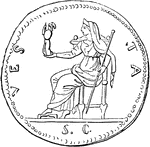
Coin of Vesta
"Represents Vesta seated on a throne, with the Palladium of Rome in her hand." — Anthon, 1891
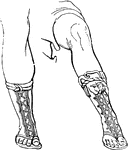
Cothurnus
"The cothurnus or buskin, rose above the midddle of the leg so as to surround the calf (sura),…
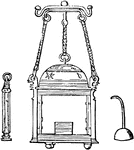
Laterna
"In later Greek, a lantern. Two bronze lanterns, constructed with nicety and skill, have been found…

Banqueting room
"The Roman people reclined at their meals. On each couch there were commonly three persons. They lay…
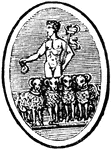
Marsupium
"Marsupium, a purse. The purse used by the ancients was commonly a small leathern bag, and was often…
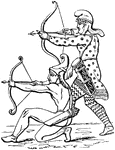
Phaetra
"A quiver, was principally made of hide or leather, and was adorned with gold, painting, and braiding.…
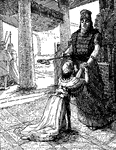
Esther Approaches King Xerxes
"Now it came to pass on the third day, that Esther put on her royal apparel, and stood in the inner…
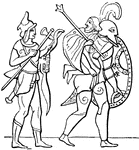
Sceptrum
"Sceptrum, which originally denoted a simple staff or walking stick, was emblematic of station and authority.…
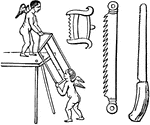
Serra
"Serra, a saw. It was made of iron. The form of the larger saw used for cutting timber is seen in the…

Speculum
"Speculum, a mirror, a looking-glass. The looking-glasses of the ancients were usually made of metal,…

Spira
"Spira, the base of a column. in the Tuscan and the Roman Doric the base consisted of a single torus,…

Cestus
"The cestus used in later times, in the public games, was a most formidable weapon. It was frequently…
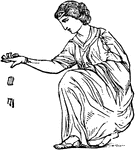
Talus
"Talus. The huckle-bones of sheep and goats were used to play with from the earliest times, principally…
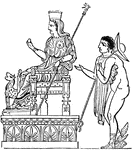
Thrones
"The following wood-cut from a fictile vase in the Museo Borbonico at Naples, represents Juno seated…
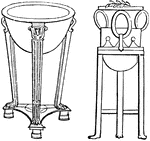
Tripos
"Tripos, a tripod, i.e. any utensil or article of furniture supported upon three feet. More especially,…
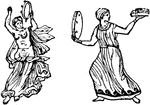
Tympanum
"Tympanum, a small drum carried in the hand. Of these, some resembled in all respects a modern tambourine…

Halt
"Carry the hand to the shoulder; rapidly thrust the hand upward the full extent of the arm several times."…

Change Direction Signal
"The hand on the side toward which the change of direction is to be made is carried across the body…



